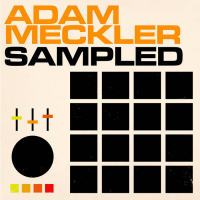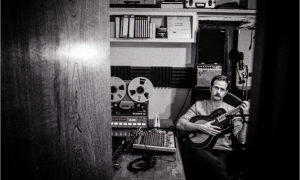The 74 pieces in the box weren't intended for commercial release by Tristano. Some were recorded on stage with basic gear without regard to sonics, most likely to listen back later to evaluate performances. Others were captured in the studio, so one can assume they were tapes of practice or warm-up sessions. Either way, they now open a new window into Tristano's improvisational and piece-development process, his unusual piano style and daring dexterity.
I wouldn't necessarily recommend this box to jazz fans unfamiliar with or new to Tristano. The material varies too much in quality and content, from the esoteric to practice and live sessions. There are far better sets that expose the newcomer to more polished Tristano in action.
However, if you are a big Tristano fan like me, then this set is a bento box of colorful musical offerings in the raw that showcase the blind pianist in different eras and settings, including working out ideas and chord voicings alone. Through the music, we are able to hear him explore, try new approaches and play behind soloing musicians.
The first CD features a potpourri of Tristano live dates accompanied by a range of different musicians between 1946 and 1948. They gigged at a mixed bag of venues in Manhattan and on Long Island. Unfortunately, the tracks are less than ideal. In some cases, it sounds as if the recording device was stopped and started to capture the piano and in other cases sounds a bit sandy. All are listenable, so kudos to Popkin for getting them to this point, sonically. One can only imagine what they must have sounded like before he worked his magic.
On the second CD, the sound improves markedly, with Tristano playing solo in 1952 at Rudy Van Gelder's studio, which was located at his parents' home in Hackensack, N.J. The CD also features Tristano alone in 1961 at his home studio on Palo Alto Street in Queens. Among the standouts are When Your Lover Is Gone, Foolish Again and a stunning Thursday Suite, which may be the box's greatest find. As with much of Tristano's solo work, the mechanical, metronome-like sound of his left hand keeping time and running a heavy bass line quickly becomes tiresome to the ear.
The third CD shifts gears and we move into spectacular territory. The personnel includes Lee Konitz (as), Warne Marsh (ts), Billy Bauer (g), Arnold Fishkin (b) and Jeff Morton (d) in 1949 and '50 at three different locations. The Carnegie Hall date in December 1949 features Joe Shulman on bass instead of Fishkin. Sound-Lee and Lennie's Changes are absolutely breathtaking. The tracks on this CD hit the jackpot.
CD4 takes us to rehearsals at Tristano's studio at 317 E. 32nd Street in Manhattan in the mid-1950s. The CD features Peter Ind (b), with Tom Wayburn (d) on a bunch while the second batch includes Al Levitt (d). Lennie's Lines, There Will Never Be Another You and Lennie's Place all are grand. [Photo above of Lennie Tristano and Peter Ind]
The fifth CD showcases undated sessions with bassist Sonny Dallas at both the E. 32nd Street and Queens studios. Due Days is a workout on Day by Day, Dream Sequence plays off chord changes to You Stepped Out of a Dream, and Friends springs off of Just Friends.
The sixth and final CD features three live performances. The first, recorded in 1948, features Konitz, Marsh, Bauer and Tristano at Lennie's residence in Flushing, Queens. The second is the Lennie Tristano Trio with Dallas on bass and Nick Stabulas on drums, recorded at New York's Half Note in 1962. The third group includes Konitz, Zoot Sims (ts), Dallas, Stabulas and Tristano at the Half Note in 1962. Marvelous music in a newly emerging vernacular from an adventuresome group of artists who changed the sound of jazz.
In the liner notes, Lenny Popkin (above) takes jazz writers to task several times for referring to the style played by Tristano as “cool jazz." I suppose I'm among those who must plead guilty. But in our defense, Tristano's music is certainly “drier," more measured and less frantic than bebop, which was in vogue in the late 1940s and early '50s. Perhaps Lee put it best in my interview with him in 2013 for a Wall Street Journal piece:
Mr. Konitz made his first cool-jazz studio recordings with the Lennie Tristano Quintet in January 1949. They launched a new freer, drier improvised sound with modern classical influences that steered clear of the blues and what Mr. Konitz now calls “show biz." “The blues never connected with me," he said. “I knew and loved Charlie Parker and copied his bebop solos like everyone else. But I didn't want to sound like him. So I used almost no vibrato and played mostly in the higher register. That's the heart of my sound."
From the writer's perspective, cool and cooler just seems a lot more colorful and easier to say than “not show biz."
One more word about the box. As I write, I'm into my third complete listen and I find that Tristano's music becomes increasingly fascinating with each go-round. Hats off to Carol Tristano, Lenny Popkin, Jerry Roche and Michael Cuscuna and the gang at Mosaic for bringing this exciting music to light. To determine if this box is for you, check out my tracks below and at the Mosaic site, where additional clips are posted. If you're a fan, this box is an elegant feast.
This story appears courtesy of JazzWax by Marc Myers.
Copyright © 2026. All rights reserved.



































